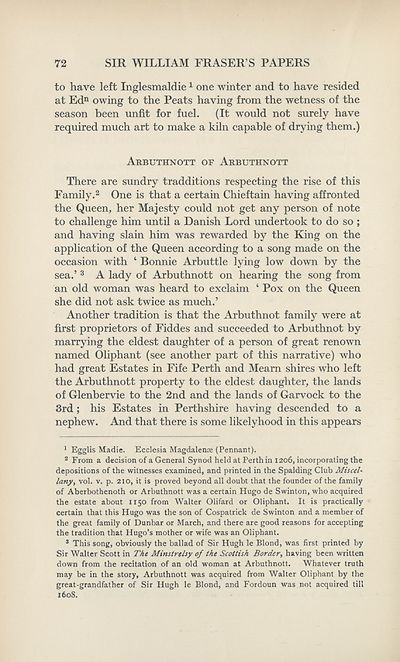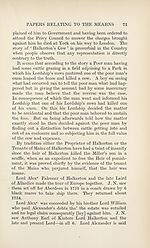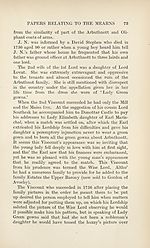Series 3 > Papers from the collection of Sir William Fraser
(109) Page 72
Download files
Complete book:
Individual page:
Thumbnail gallery: Grid view | List view

72
SIR WILLIAM FRASER S PAPERS
to have left Inglesmaldie1 one winter and to have resided
at Edn owing to the Peats having from the wetness of the
season been unfit for fuel. (It would not surely have
required much art to make a kiln capable of drying them.)
Arbuthnott of Arbuthnott
There are sundry tradditions respecting the rise of this
Family.2 One is that a certain Chieftain having affronted
the Queen, her Majesty could not get any person of note
to challenge him until a Danish Lord undertook to do so ;
and having slain him was rewarded by the King on the
application of the Queen according to a song made on the
occasion with ‘ Bonnie Arbuttle lying low down by the
sea.’3 A lady of Arbuthnott on hearing the song from
an old woman was heard to exclaim ‘ Pox on the Queen
she did not ask twice as much.’
Another tradition is that the Arbuthnot family were at
first proprietors of Fiddes and succeeded to Arbuthnot by
marrying the eldest daughter of a person of great renown
named Oliphant (see another part of this narrative) who
had great Estates in Fife Perth and Meam shires who left
the Arbuthnott property to the eldest daughter, the lands
of Glenbervie to the 2nd and the lands of Garvock to the
3rd ; his Estates in Perthshire having descended to a
nephew. And that there is some likelyhood in this appears
1 Egglis Madie. Ecclesia Magdalena (Pennant).
2 From a decision of a General Synod held at Perth in 1206, incorporating the
depositions of the witnesses examined, and printed in the Spalding Club Miscel¬
lany, vol. v. p. 210, it is proved beyond all doubt that the founder of the family
of Aberbothenoth or Arbuthnott was a certain Hugo de Swinton, who acquired
the estate about 1150 from Walter Olifard or Oliphant. It is practically
certain that this Hugo was the son of Cospatrick de Swinton and a member of
the great family of Dunbar or March, and there are good reasons for accepting
the tradition that Hugo’s mother or wife was an Oliphant.
3 This song, obviously the ballad of Sir Hugh le Blond, was first printed by
Sir Walter Scott in The Minstrelsy of the Scottish Border, having been written
down from the recitation of an old woman at Arbuthnott. Whatever truth
may be in the story, Arbuthnott was acquired from Walter Oliphant by the
great-grandfather of Sir Hugh le Blond, and Fordoun was not acquired till
1608.
SIR WILLIAM FRASER S PAPERS
to have left Inglesmaldie1 one winter and to have resided
at Edn owing to the Peats having from the wetness of the
season been unfit for fuel. (It would not surely have
required much art to make a kiln capable of drying them.)
Arbuthnott of Arbuthnott
There are sundry tradditions respecting the rise of this
Family.2 One is that a certain Chieftain having affronted
the Queen, her Majesty could not get any person of note
to challenge him until a Danish Lord undertook to do so ;
and having slain him was rewarded by the King on the
application of the Queen according to a song made on the
occasion with ‘ Bonnie Arbuttle lying low down by the
sea.’3 A lady of Arbuthnott on hearing the song from
an old woman was heard to exclaim ‘ Pox on the Queen
she did not ask twice as much.’
Another tradition is that the Arbuthnot family were at
first proprietors of Fiddes and succeeded to Arbuthnot by
marrying the eldest daughter of a person of great renown
named Oliphant (see another part of this narrative) who
had great Estates in Fife Perth and Meam shires who left
the Arbuthnott property to the eldest daughter, the lands
of Glenbervie to the 2nd and the lands of Garvock to the
3rd ; his Estates in Perthshire having descended to a
nephew. And that there is some likelyhood in this appears
1 Egglis Madie. Ecclesia Magdalena (Pennant).
2 From a decision of a General Synod held at Perth in 1206, incorporating the
depositions of the witnesses examined, and printed in the Spalding Club Miscel¬
lany, vol. v. p. 210, it is proved beyond all doubt that the founder of the family
of Aberbothenoth or Arbuthnott was a certain Hugo de Swinton, who acquired
the estate about 1150 from Walter Olifard or Oliphant. It is practically
certain that this Hugo was the son of Cospatrick de Swinton and a member of
the great family of Dunbar or March, and there are good reasons for accepting
the tradition that Hugo’s mother or wife was an Oliphant.
3 This song, obviously the ballad of Sir Hugh le Blond, was first printed by
Sir Walter Scott in The Minstrelsy of the Scottish Border, having been written
down from the recitation of an old woman at Arbuthnott. Whatever truth
may be in the story, Arbuthnott was acquired from Walter Oliphant by the
great-grandfather of Sir Hugh le Blond, and Fordoun was not acquired till
1608.
Set display mode to:
![]() Universal Viewer |
Universal Viewer | ![]() Mirador |
Large image | Transcription
Mirador |
Large image | Transcription
Images and transcriptions on this page, including medium image downloads, may be used under the Creative Commons Attribution 4.0 International Licence unless otherwise stated. ![]()
| Scottish History Society volumes > Series 3 > Papers from the collection of Sir William Fraser > (109) Page 72 |
|---|
| Permanent URL | https://digital.nls.uk/126812439 |
|---|
| Attribution and copyright: |
|
|---|
| Description | Over 180 volumes, published by the Scottish History Society, containing original sources on Scotland's history and people. With a wide range of subjects, the books collectively cover all periods from the 12th to 20th centuries, and reflect changing trends in Scottish history. Sources are accompanied by scholarly interpretation, references and bibliographies. Volumes are usually published annually, and more digitised volumes will be added as they become available. |
|---|


